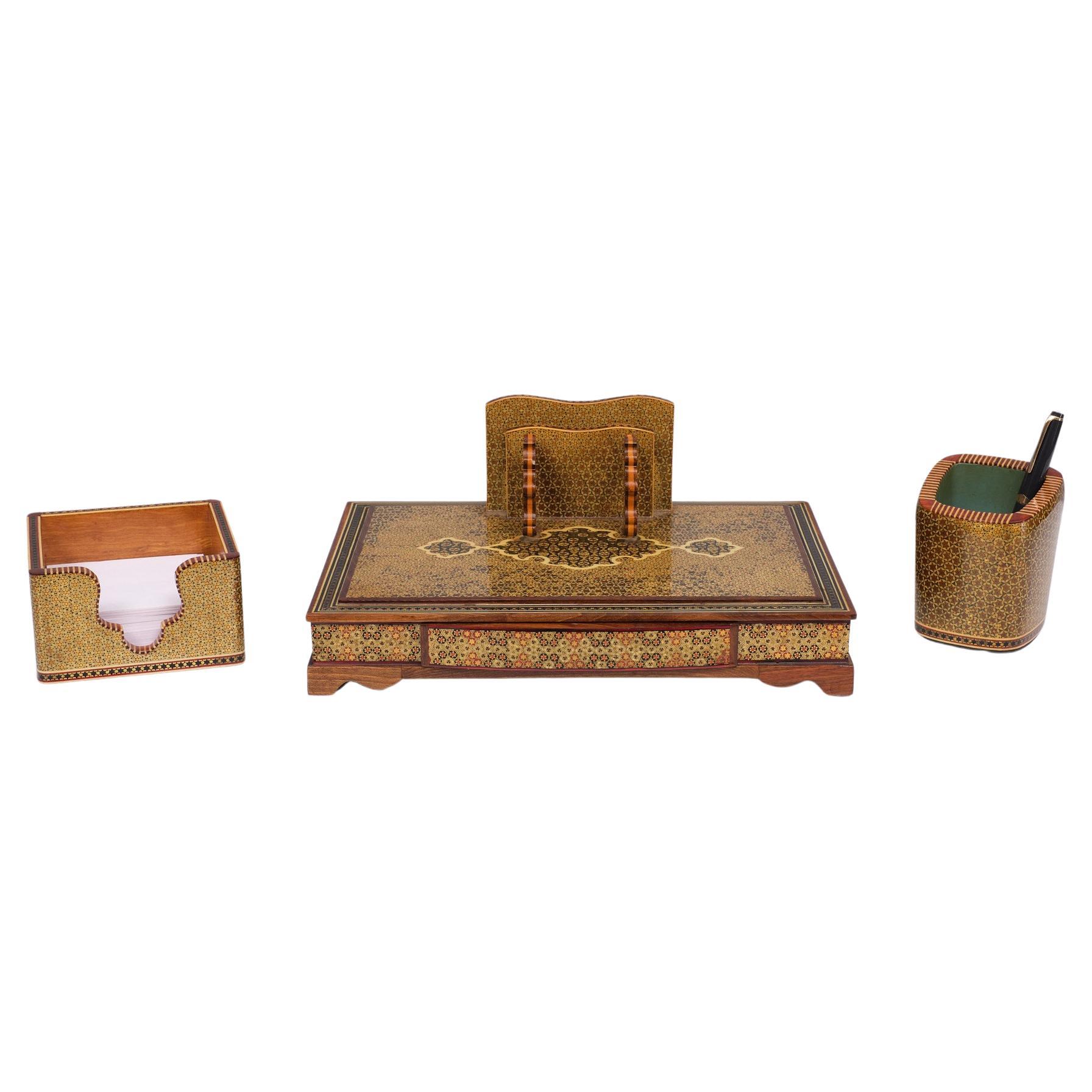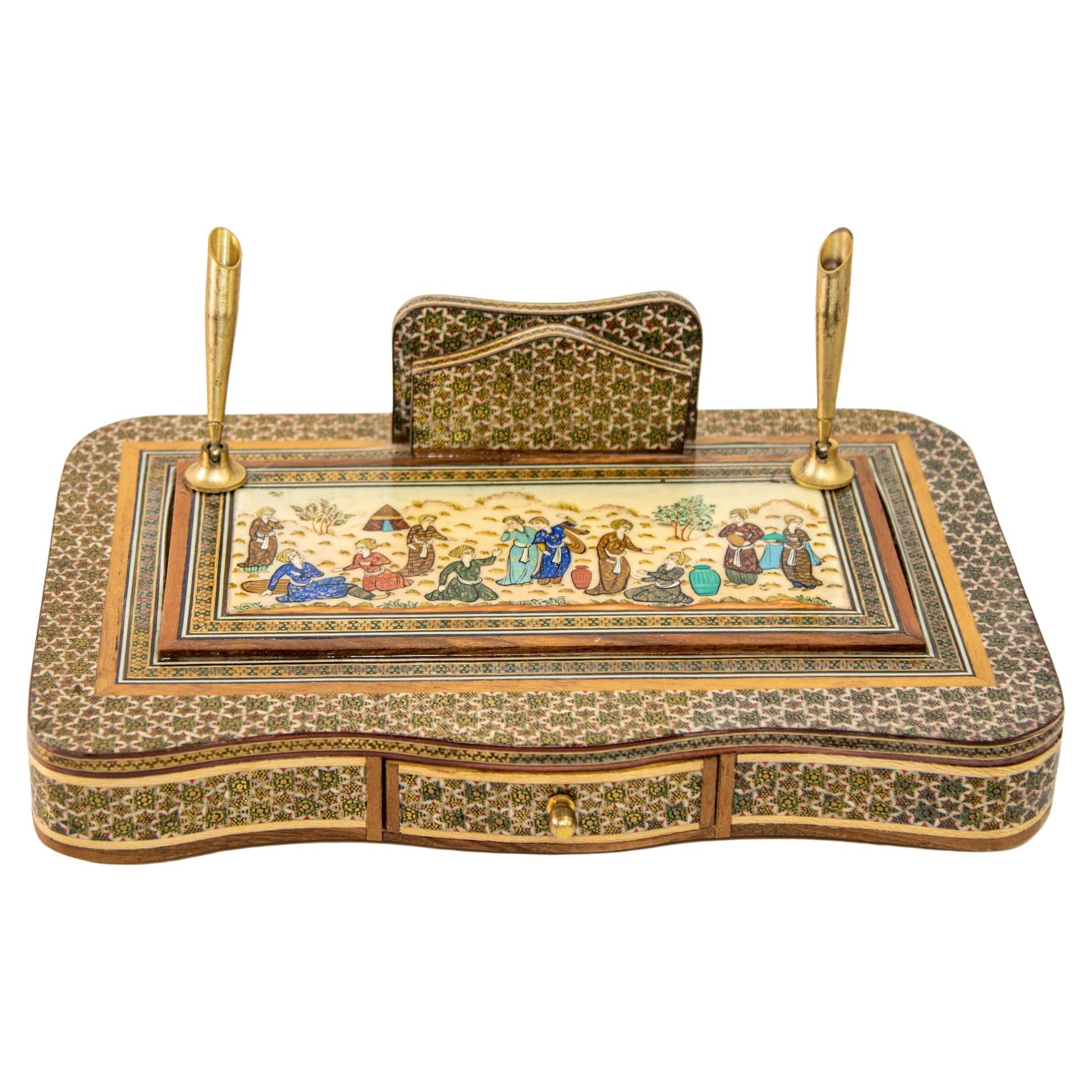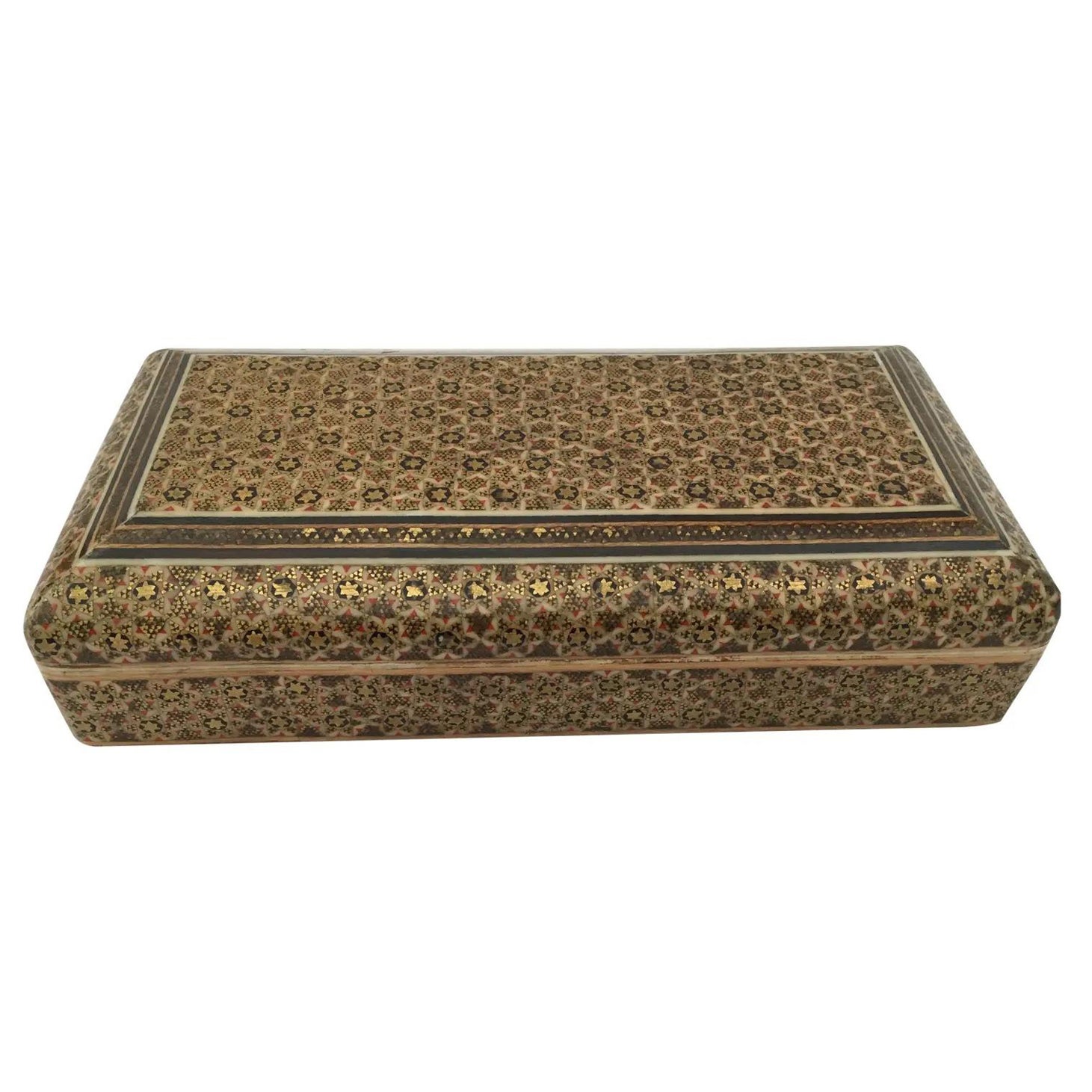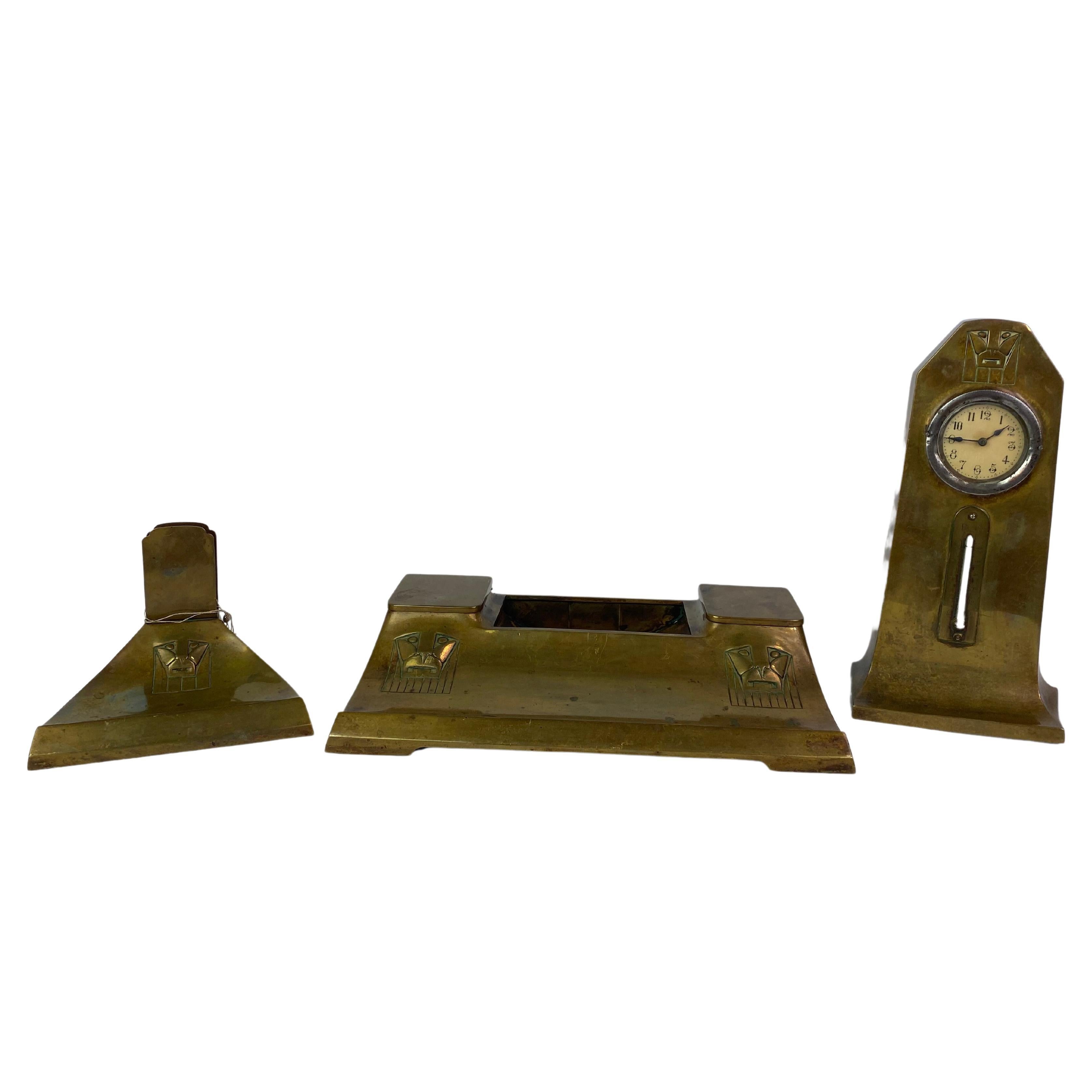Items Similar to Persian Desk Set with Khatam Mosaic
Want more images or videos?
Request additional images or videos from the seller
1 of 10
Persian Desk Set with Khatam Mosaic
About the Item
PRESENTING A LOVELY Hand-painted Persian Desk Set with Khatam Mosaic.
Pair of items in the Set:
(1) Hand-painted Bone Plaque in Khatam Mosaic Frame, and
(2) Desk Companion Stand with brass pen holders, Stationery Holder and hand-painted Bone Plaque in Khatam Mosaic.
The framed plaque features a ‘Polo’ scene with 3 figures in tribal dress on horseback with polo sticks and ball, probably made circa 1960. Classic vintage Khatam mosaic. The bone panel in the frame, is beautifully painted and matted with hand painted Islamic style borders.
The desk stand plaque features a ‘Hunting” scene, with 2 riders in tribal dress, one with bow and arrow and a pair of animals (probably deer). Classic contemporary Khatam mosaic. Sits on 4 triangular platform feet. The pen holders are brass and are on a swivel ball hinge. Made in 2006 as noted on the base.
Note: The 2 gold pens, seen in the photos with the desk stand, are not included.
“Khātam (Persian: خاتم) is a Persian version of marquetry, art forms made by decorating the surface of wooden articles with delicate pieces of wood, bone and metal precisely-cut geometrical shapes. Khatam is also the capital of Khatam County in Iran. Khatam kari (Persian: خاتمکاری) is the art of crafting a Khatam. Common materials used in the construction of inlaid articles are gold, silver, brass, aluminum and twisted wire.
Designing of inlaid articles is a highly elaborate process. In each cubic centimeter of inlaid work, up to approximately 250 pieces of metal, bone, ivory and different kinds of wood are laid side by side, glued together in stages, smoothed, oiled and polished. Inlaid articles in the Safavid era took on a special significance as artists created their precious artworks. Woods used include betel, walnut, cypress and pine. These works include doors and windows, mirror frames, Quran boxes, inlaid boxes, pen and penholders, lanterns and shrines“
Provenance: Bought from an Antique Market in London.
Dimensions: (1) Frame: 9.75 in wide x 7 in high. Bone Panel: 5 in wide x 2.5 in high
(2) Desk Stand: 8 in Wide, 6 in Deep and 3.5 in tall
Condition: Both are in very good original condition. Some very minor repairs to the bottom edging of the frame but not significant or noticeable.
- Dimensions:Height: 3.5 in (8.89 cm)Width: 8 in (20.32 cm)Depth: 6 in (15.24 cm)
- Sold As:Set of 2
- Style:Islamic (In the Style Of)
- Materials and Techniques:
- Place of Origin:
- Period:
- Date of Manufacture:1960
- Condition:Repaired: Some very minor repairs to the bottom edging of the frame but not significant or noticeable. Wear consistent with age and use.
- Seller Location:Dallas, TX
- Reference Number:1stDibs: LU3978137803732
About the Seller
4.9
Platinum Seller
These expertly vetted sellers are 1stDibs' most experienced sellers and are rated highest by our customers.
Established in 2015
1stDibs seller since 2018
349 sales on 1stDibs
Typical response time: <1 hour
- ShippingRetrieving quote...Ships From: Dallas, TX
- Return PolicyA return for this item may be initiated within 7 days of delivery.
More From This SellerView All
- 19th Century British Tunbridge Ware Lap DeskBy Tunbridge WareLocated in Dallas, TXPresenting an absolutely gorgeous and extremely unique and rare 19th Century British Tunbridge ware lap desk. This lap desk is unlike any of it’s kind we have seen before. From cir...Category
Antique Mid-19th Century English High Victorian Decorative Boxes
MaterialsWood, Ebony, Maple, Satinwood, Walnut
- Art Deco Style Chrome or Silveroid Desk TimepieceLocated in Dallas, TXPresenting a lovely Art Deco style chrome or silveroid desk timepiece. Probably made circa 1980. The case is a solid circular shaped chrome or sil...Category
20th Century American Art Deco More Clocks
MaterialsSilver Plate, Chrome
- 19C British Coromandel, Brass with Large Jasperware Medallions Book SlideLocated in Dallas, TXPRESENTING A GORGEOUS, VERY HIGH QUALITY AND RARE 19C British Coromandel, Brass with Large Jasperware Medallions Book Slide. Probably made in England...Category
Antique 19th Century English Victorian Desk Sets
MaterialsBrass
- 19C Anglo Indian Highly Carved Padouk Wood with Sadeli Mosaic Inlay Sewing BoxLocated in Dallas, TXPRESENTING A LOVELY 19C Anglo Indian Highly Carved Padouk Wood with Sadeli Mosaic Inlay Sewing Box. Made in Bombay, India, circa 1880. The box is made of sandalwood with highly carved raised padouk wood panels on all sides, depicting temple scenes, animals and foliage. The box is in a sarcophagus form. It is edged in bone (and we can tell it is bone and not ivory, from the color and evidence of capillaries, which are not found in ivory), and banded with Bombay Sadeli mosaic and ebony veneer. The lid opens to reveal a removable tray with various open compartments and lidded compartments. 5 lidded compartments, 1 unlidded compartment and 8 holders for thimbles, etc The tray lifts to reveal a blue velvet (original) lined section, for storing jewelry etc, with sections for collars etc. The inside of the lid has a removable mirror (the mirror is missing on this one but can easily be replaced). Behind the mirror is the original green velvet lining. It has its original brass carry handles on the sides and sits on 4 silvered button feet (of recent origin). Some repairs to the exterior and condition issues (priced accordingly), but still a LOVELY COLLECTIBLE box! These boxes were made by superb Indian craftsmen, specifically for sale to the ruling British elite. These types of boxes, carved padouk and sandalwood, (whilst beautiful and superbly crafted) were of a lesser quality, than the more profusely and intricately mosaic inlay, tortoiseshell and ivory boxes, made for the British ‘Upper Classes’ in the areas of Bombay and Vizagapatam. These type of boxes were much more affordable back in 1880 (and indeed today) and would probably have been bought by mid-level diplomats, civil servants or visitors. Sewing boxes (in general), were in EVERY Victorian home in Britain in the 19th century and like other boxes etc were ‘status symbols’ of your place in society! The more ornate the box, the more ‘Upper Class’ you were! SADELI MOSAIC: “Anglo Indian boxes were made in India for the English residents from the early part of the 18th century. They were brought back or sent back to England usually by the people who had commissioned them. From the beginning of the nineteenth century they were imported more commercially, although not in any significant numbers until the middle decades. They were very highly valued, especially the early ones, to the extent that the designs were copied on late 19th and early 20th century tins. The ancient art of Sadeli Mosaic is said to have been introduced from Shiraz in Persia via Sind to Bombay, a long time before the Anglo Indian boxes were made. It was a technique, which required a high degree of skill and patience. It was executed very lavishly, in that the frequent cuts wasted a great amount of the precious materials used. The workmanship was however more than commensurable to the value of the materials. Ivory, silver, pewter (or other metals), wood and Horn were cut into faceted rods which were bound together to form geometric patterns. When the glue has set, the rods were sliced in transverse sections. This gave the maker a number of angled circular pieces in the original pattern. Several variations of patterns could be achieved by combining the materials in different ways. The ivory was sometimes dyed green to give an extra color. The mosaic pieces in a combination of patterns, often separated by ivory, ebony, Horn or silver stringing were used to veneer sandalwood boxes. In the early boxes, which date from the turn of the 18th to the 19th century, there are large panels of mosaic covering tops and sides of boxes. It took incredible skill to cover such large areas without any shakes or wavering of the pattern. The corners and joins on these boxes are impeccably matched. The makers (reputed to be Persian) of Sadeli mosaic made in the first two decades of the 19th century displayed a total understanding of the qualities of the different materials they used. They combined substances, which can expand and contract according to atmospheric conditions with others, which are hard and unyielding. The result was a sharp definition of the lines and patterns, which made up the whole design. On the early boxes the designs look deceptively simple. The fact is, they emerged from a culture, which had mastered geometry and understood how to generate a pattern from a set number of points. The patterns are so harmoniously combined that their incredible complexity is not immediately apparent. The earliest Sadeli boxes...Category
Antique Late 19th Century Indian Anglo-Indian Decorative Boxes
MaterialsBone, Padouk, Sandalwood
- Set of 6 Mindanao Brass Silver Betel Boxes, PhilippinesLocated in Dallas, TXPresenting an amazing set of 6 Mindanao brass silver betel boxes, Philippines. Betel chewing was prevalent in the southern Philippines as in much o...Category
Antique Late 19th Century Philippine Islamic Tea Caddies
MaterialsSilver, Brass, Copper
- 19C English Tunbridgeware Tabletop Stationary Box, Micro MosaicBy Tunbridge WareLocated in Dallas, TXStunning little 19th century tabletop stationary box made of micro-mosaic. Made in Britain, circa 1870, in Tunbridge Wells, hence these type of works are called Tunbridgeware! ...Category
Antique Late 19th Century English High Victorian Decorative Boxes
MaterialsBurl, Boxwood, Ebony, Walnut
You May Also Like
- Vintage 1950s Persian Khatam Pen and Letter Desk SetLocated in Den Haag, NLVery nice Three piece desk set The mosaic design work is gorgeous, using various color woods and other natural materials. This wooden desk set pen h...Category
Vintage 1950s Iraqi Islamic Desk Sets
MaterialsWood
- Vintage 1950s Persian Khatam Hand Painted Pen and Letter Desk SetLocated in North Hollywood, CAVintage 1950s Persian Khatam desk set in solid wood Mosaic inlay with brass tips pen holder. The wooden base is khatam covered and there is a miniature painting scene in the top flat...Category
Mid-20th Century Asian Islamic Desk Sets
MaterialsFruitwood
- Indo-Persian Khatam Micro Mosaic Jewelry BoxLocated in North Hollywood, CAHandcrafted Khatam wooden box with very delicate micro mosaic marquetry from the ancient Persian technique of inlaying from arrangements of so many delicate pieces of wood, precious wood, and delicate miniatures paintings. This beautiful Middle Eastern Persian style box is covered inside and out with fine Moorish micro mosaic marquetry. Indo Persian Moorish style micro mosaic inlaid jewelry box with lid. Intricate inlaid Asian Indian box with floral and geometric Islamic Moorish Sadeli design in a square shape form with inlay marquetry, very fine artwork, lined in red velvet. Museum collector piece like the one in Doris Duke Islamic Art Museum. The repeating geometric patterns of Sadeli Mosaic are what give it beauty and richness. This decorative technique is a type of micro mosaic featuring repeating geometric patterns. A highly skilled craft, it has had a long history in India and the Middle East with early examples dating back to the 16th century. In the 1800s, it became popular as a decoration on a variety of boxes, card cases, and chess boards imported from India. Since Bombay became a center of making them, they became known as Bombay boxes...Category
Mid-20th Century Asian Moorish Decorative Boxes
MaterialsWood
- Brass jugendstil desk set with lion headsLocated in Banská Štiavnica, SKBrass jugendstil desk set with lion heads. inkwell 28,5x18,5x6cm clock 24,5x13x8cm match stand with ashtray 14x13x11,5cmCategory
Vintage 1910s Austrian Jugendstil Desk Sets
MaterialsBrass
- Middle Eastern Persian Micro Mosaic Khatam Inlaid Jewelry BoxLocated in North Hollywood, CALarge Middle Eastern Indo-Persian Micro Mosaic Khatam Inlaid Wooden Jewelry Box. Middle Eastern Persian Sadeli micro mosaic marquetry inlaid box with geometric Moorish design. Handcrafted Khatam wooden box with very delicate micro mosaic marquetry from the ancient Middle Eastern technique of inlaying from arrangements of so many delicate pieces of precious hand painted wood, with bone around the edges. This beautiful Middle Eastern Persian, Indian Wooden box is covered with fine Moorish micro mosaic marquetry and is used as a jewelry, trinket box. Lined in deep red velvet. Dimensions: 6.5in.D x 3in.H x 10 wide. Nice Indian Mughal, Indo Persian Box...Category
Mid-20th Century Indian Moorish Jewelry Boxes
MaterialsFruitwood
- Desk Accessories Magnifying Glass and Letter Opener Desk Set with 1970Located in Auribeau sur Siagne, FRDesk Accessories Magnifying Glass and Letter Opener Desk Set with 1970 Excellent vintage condition. Paris, in the traditions of French big houses like Lancel or Dior.Category
Vintage 1970s French Mid-Century Modern Desk Sets
MaterialsBrass
Recently Viewed
View AllMore Ways To Browse
Italo Leather In And Out Tray
Gucci Note Pad
Mail Openers
Giorgio Della Beffa
Hermes Saddle Pad Used
Hermes Writing Pad
Louis Comfort Tiffany Peacock Stained Glass
Marianne Brandt Scale
Mcm Sewing
Parker Pen Set Vintage
Peacock Tiffany Stained Glass
Pen Holder Fornasetti
Pierre Cardin Porcelain Set
Rolex Pen Set
Saint Gobain On Sale
Vintage Art Nouveau Brass Inkwell Inkwells
Vintage Dance Card Holder
Vintage Eversharp





